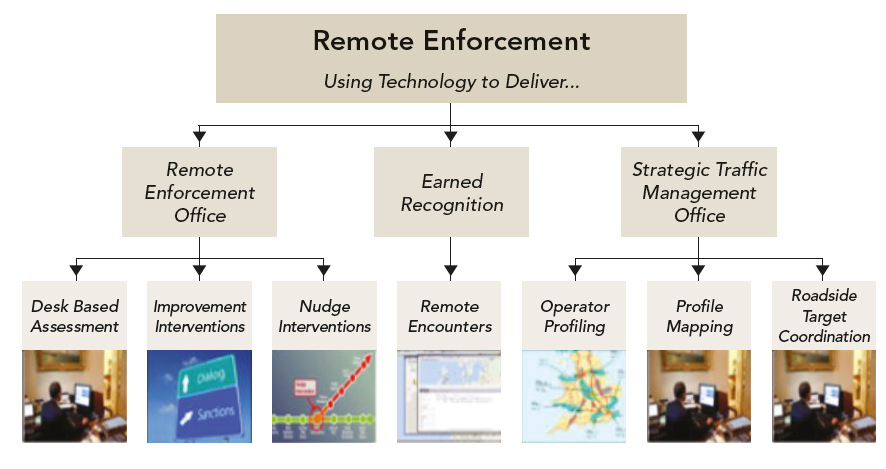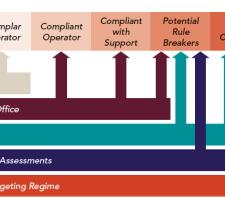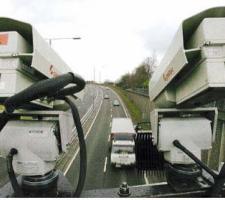
The UK’s DVSA is utilising existing technology to identify non-compliant commercial vehicles and target repeat offenders while avoiding law-abiding companies.
Enforcing the compliance of commercial vehicles (goods vehicles over 3.5 tonnes and vehicles with eight or more passenger seats) on the UK’s roads is the responsibility of the DVSA (the Driver and Vehicle Standards Agency). The Department for Transport created the executive agency about 18 months ago by merging the Driving Standards Agency (DSA) and the Vehicle and Operator Services Agency (VOSA).
The new agency inherited a situation where compliance rates for commercial vehicles has remained almost static at between 11% and 13% for the last 15 years, Caroline Hicks, DVSA’s head of enforcement transformation, told the ITS UK’s Enforcement conference. “So what we have been doing for the past 15 years had not significantly influenced the state of the fleet,” she said.
The new department has to achieve better results with less resources and is utilising technology installed by other authorities and existing data from various sources to identify non-compliant vehicles and target offending companies with the aim of improving future compliance.
“With better information we can more effectively target defective vehicles and their operators and introduce additional interventions at an appropriate level. We are working with the industry on compliance and ways to deliver better enforcement.”
The targeting of overweight and defective vehicles has improved and around 25% of vehicles escorted to enforcement stations receive a prohibition or fixed penalty notice but the overall compliance remains stubbornly static. “At least one in 10 goods vehicles has some form of non-compliance and some operators have come to see prohibitions as an ‘occupational hazard’ and take the view ‘everybody gets them and it was our turn today’,” said Hicks.
While the DVSA and its predecessors had been seen as hard-line enforcers, Hicks said the approach is changing and the agency wants to work with compliant companies and thereby free up resources to target non-compliant operators. Its plan is to develop systems to better target defective vehicles while also identifying and rewarding diligent law-abiding companies.
To that end it is utilising information from Highways England’s camera network along with data - its own, from other authorities or from the vehicle operator.
This new approach is based on dividing commercial vehicle operators into six categories from ‘exemplar’ through ‘compliant with support to ‘serious’ and ‘serial non-compliant’ (see illustration).
“It is about identifying the operators’ culture and using remote technology to encourage compliance,” Hicks said.
The system has three components: remote enforcement; earned recognition and strategic traffic management. Remote enforcement starts with a desk-based assessment of documentation requested from the vehicle operator – which removes the need for many costly and time-consuming site visits. It is also more efficient for the operator who does not have to wait around for the scheduled visit.
A data feed from Highways England helps identify operators with a high incidence of vehicles breaking down on motorway hard shoulders and other major routes. The DVSA will send a letter to those companies enquiring why these problems keep occurring. A similar letter is sent when an insecure load is identified from the CCTV footage.
“There is no point doing a site visit as that load will be long gone, instead we ask what systems the operator now has in place to prevent any reoccurrence. When we contact them they realise that they are ‘on our radar’ and need to make improvements,” Higgs told delegates.
DVSA already holds a plethora of information about operators including vehicle test result and prohibitions, and these are monitored for any sign of deterioration. Should the records start to show a fall-off in compliance, the operator will receive a letter enquiring what is causing the deterioration.
“These are potentially tomorrow’s law breakers and we are letting them know that we are watching them and if they don’t improve we will target their vehicle for roadside checks. The aim is to try to stop operators doing things wrong before they start posing a danger,” she explained.
Cross-checking the operator’s information with the DVSA’s documents helps detect those who set out to cheat the system. “We do pick up falsifications which is an indictable offence - they could lose their operators’ licence or even go to prison,” Hicks warns.
A live network feed from DVSA’s own networked ANPR cameras is used to identify vehicles that are of interest for detecting driver’s hours and/or speeding offences – especially for vehicles arriving at one of the UK’s many ports (54% of all the vehicles stopped at roadside are owned by non-UK operators). “We know how long it takes to drive from Dover to Birmingham at 90km/h [56mph] including the driver taking their statutory break. So if the ANPR picks them up outside of where they should be, we know they are likely to have committed one offence or another,” Hicks told ITS International.
At the other end of the scale, she described exemplar operators as those who have invested in their operation including the fitment of telematics equipment to record how a vehicle is being driven, and then provide DVSA with access to that data. “Then we don’t need to stop those trucks at the roadside,” said Hicks.
While that may not seem the greatest of rewards, the 45 minutes typically taken checking a vehicle has been estimated by one UK supermarket to cost between £4,000 and £4,500 ($6,150 and $6,900).
Live tachograph data is also available through the operators’ telematics systems.
The authority is continuing to evaluate the reuse of existing systems and information and Hicks said talks with industry associations are ongoing.
In the new enforcement regime DVSA’s Strategic Traffic Management Office analyses the available data to identify the worst offenders. It then uses the live networked ANPR feeds to determine the routes used by targeted operators’ vehicles and the days and times they pass each of the cameras. “We can determine that a particular operators’ vehicles are most likely to be seen on particular roads during certain days of the week and identify the time to within a few hours. We can then put our people at the right places at the right time to target that operator,” said Hicks.
She gave the example of an un-named operator who had been a top 10 target since 2008. The company runs 160 vehicles but is not based in the UK.
“For six years we knew this operation posed a serious safety risk but nothing we had done had changed the company’s behaviour. We had targeted the roads its trucks use but when we set up a check, their vehicles never passed. We know that social media messaging is used by drivers and operators to identify where we are working - which is probably why we did not see them. So that strategy didn’t work.
“They were making so much money through being non-compliant that the costs of fixed penalty notices and prohibitions were factored into their charging structure, knowing that if they were stopped it would cost them £200 or £300.”
To tackle the problem DVSA set up ‘Operation Aeries’ which ran for two hours on consecutive nights at locations across the Midlands (identified by the Strategic Traffic Management Office) and stopped all 31 of the operator’s vehicles running on UK roads. In order to prevent the operator ordering a diversion to avoid static checkpoints, officers in a car located and followed each truck on the identified routes.
Of the vehicles stopped, 19 had defects or there were driving offences (such as excess hours) and 13 were issued with prohibitions or fixed penalty notices.
“At 4am on the second day the operator rang us and said ‘I give up, I will put everything right - I can’t afford to work like this’,” Hicks told the audience, adding: “that was seven months ago and he has remained compliant ever since. After six years of targeting this operator, we sorted the problem in four hours.
“While the operator could factor in the cost of random prohibitions and fixed penalty notices in its contracts, it could not operate when every one of its vehicles was stopped and we understand they lost two contracts due to the disruption we caused.”
This enforcement targeting complements an increasing network of weigh-in-motion sensors placed on the strategic network.
Hicks believes that in the future, companies placing transport and distribution contracts will favour the compliant and exemplar operators because their deliveries will be made on time without disruption by enforcement actions. “It will be a cultural change for the industry and our own staff too,” Hicks concluded.















